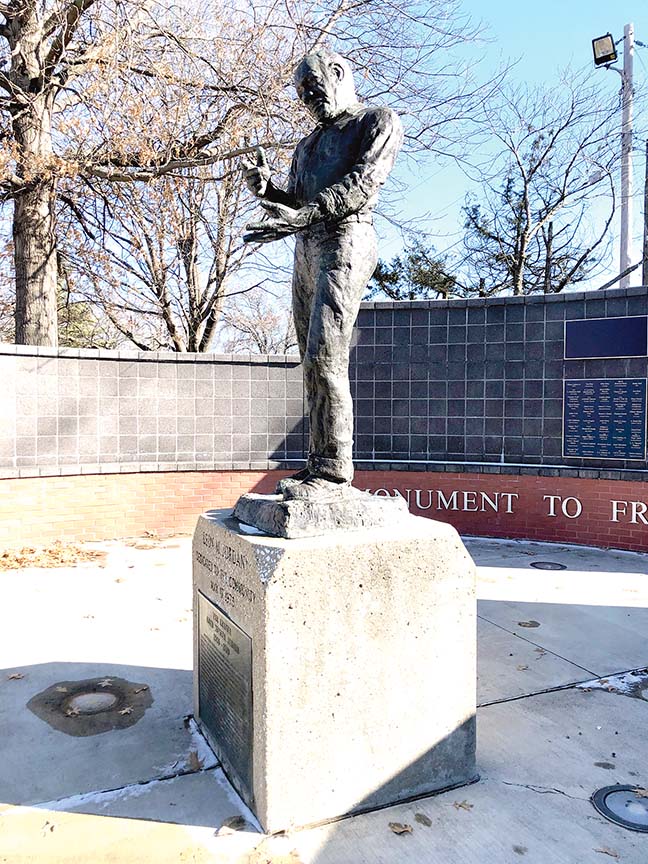
Dorri Partain
Contributor
Born in Kansas City, Mo., in 1905, Leon Mercer Jordan is noted for his legacy as being the first Black police officer promoted to lieutenant, the first Black state representative, and the first Black person to be honored with a park and monument.
After graduating from Lincoln High School, he attended a historically Black university, Wilberforce University in Wilberforce, Ohio. There he met Orchid Ramsey, whom he married after their graduation in 1932.
After teaching for several years, Jordan joined the Kansas City Police Department (KCPD) in 1938, earning the rank of lieutenant before moving to Liberia, Africa, in 1947 to head a police force there. Jordan led a force of 450 officers and piloted his own plane to patrol the vast amount of land.
In 1955, after moving back to Kansas City, he purchased the Green Duck Tavern at 2548 Prospect; he and Orchid lived in an apartment upstairs. The tavern was often the site for political discussions, and Jordan decided the Black community needed a voice. He ran as a candidate for the Democratic Committeeman for the 14th Ward election in 1958 and won.
Jordan teamed up with another aspiring Black politician, Bruce R. Watkins Sr., and they formed Freedom, Inc. to promote Black votership and candidates in 1962. Watkins was elected to the City Council in 1963 and Jordan was elected to Missouri House of Representatives, 11th District, in 1964.
He served three terms and was seeking re-election when on the early morning of July 15, 1970, as Jordan was closing the tavern for the day, three shots rang out, striking Jordan and killing him. The murder shocked citizens and politicians, both Black and white, as the news traveled across the city and state. While several suspects were identified, none were found guilty and Jordan’s murder remains unsolved today.
The call to create a memorial for Jordan was championed by Bobby Scroggins, a student at Central High School, who had created a clay bust of Jordan. Scroggins had never met Jordan, but was impressed by his leadership. Reaching out to Watkins and Jordan’s widow, Orchid, Scroggins used the bust as a prototype for a full-size monument that he would later create.
In 1972, the Jackson County Legislature purchased several lots at 31st Street and Benton Boulevard. Several abandoned buildings were razed and a ground-breaking ceremony was held on August 5, 1972, to begin construction of the one-acre green space.
By May of 1974, the plot was landscaped with walkways and plants, awaiting the monument. Scroggins, by then a student at the Kansas City Art Institute, began work on a likeness of Jordan that would stand seven feet tall and weigh 700 pounds when completed.
“While I had only seen Jordan wearing a suit, that was not how I wanted to depict him, as a ‘suit.’ I saw him as a working man, out talking to people, having a conversation with them,” Scroggins said of the likeness he designed.
Even though the commission was in addition to his school sculpting projects, Scroggins did all the work at the institute, from sculpting the clay model to creating the mold and pouring the molten bronze in the mold – with some assistance from other students.
“It was a very dangerous process,” Scroggins explained. “We had an accident and the mold was slightly cracked, which can greatly affect the final cast. But we were able to rectify that and it came out okay.”
Scroggins was also given a very short timeline to complete the statue; the dedication ceremony was scheduled for May 17, 1975, and went on as scheduled even though the monument would not be completed and installed until July.
During the dedication, Watkins spoke about the tribute to his good friend, saying, “It is in honor of a man who started a movement, who believed in working within the system, making the system work for people who had never been able to achieve before.”
Scroggins, now a professor at the University of Kentucky’s College of Fine Arts, recalls the statue’s creation as a “challenging project.”
“For the scale, it was under budget, less than half the cost that would be raised for that size, so that’s why I cast it myself,” Scroggins said. “There was no profit. After the cost of materials and the hours spent, I made 29 cents an hour. But even knowing that then, I still would have done it.”
Leon M. Jordan Memorial Park is maintained by the Jackson County Parks Department. In 2014, the Monument to Freedom, a tribute to additional leaders in the Black community was built to encircle the Jordan monument.

















